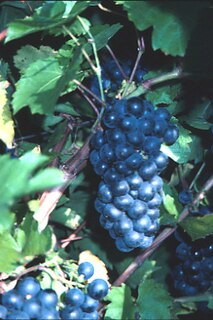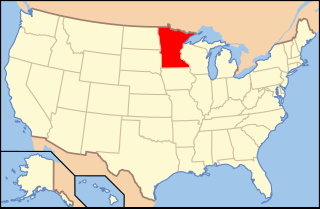
A grape is a fruit, botanically a berry, of the deciduous woody vines of the flowering plant genus Vitis.

Merlot is a dark blue-colored wine grape variety, that is used as both a blending grape and for varietal wines. The name Merlot is thought to be a diminutive of merle, the French name for the blackbird, probably a reference to the color of the grape. Its softness and "fleshiness", combined with its earlier ripening, makes Merlot a popular grape for blending with the sterner, later-ripening Cabernet Sauvignon, which tends to be higher in tannin.

PinotagePIN-ə-tahzh is a red wine grape that is South Africa's signature variety. It was bred there in 1925 as a cross between Pinot noir and Cinsaut. It typically produces deep red varietal wines with smoky, bramble and earthy flavors, sometimes with notes of bananas and tropical fruit, but has been criticized for sometimes smelling of acetone. ISBN 1-85732-999-6</ref> The grape is a viticultural intraspecific cross of two varieties of Vitis vinifera, not an interspecific hybrid.

Alicante Bouschet or Alicante Henri Bouschet is a wine grape variety that has been widely cultivated since 1866. It is a cross of Petit Bouschet and Grenache. Alicante is a teinturier, a grape with red flesh. It is one of the few teinturier grapes that belong to the Vitis vinifera species. Its deep colour makes it useful for blending with light red wine. It was planted heavily during Prohibition in California for export to the East Coast. Its thick skin made it resistant to rot during the transportation process. The intense red color was also helpful for stretching the wine during prohibition, as it could be diluted without detracting from the appearance. At the turn of the 21st century, Alicante Bouschet was the 12th most planted red wine grape in France with sizable plantings in the Languedoc, Provence and Cognac regions. In 1958, Alicante Bouschet covered 24,168 hectares ; by 2011, plantings represented less than 4,000 hectares. This scenario is largely reversed in other regions of Europe, and in southern Portugal, where its wines are highly prized and frequently outscore traditional autochthonous varieties.
St. Pepin is a modern hybrid variety of wine grape, mostly grown in North America. It produces grapes suitable for making fruity white wines similar to Riesling or as a base for blended wines. The grapes also make a good seeded table grape for eating. It has the benefits of early ripening and when hardened properly in the fall it is winter hardy to at least −25 °F (−32 °C). As such, it best suited to growing in more northern climates.
Edelweiss is a very winter-hardy wine grape variety, pale green in color, derived from crossing the Minnesota 78 and Ontario grapes. It was developed by Elmer Swenson in 1980 in cooperation with the University of Minnesota. The clusters are large and rather loose, weighing a pound or more. Early picking of the grape is essential for making a wine. Should Edelweiss not be harvested early, the completely ripe Vitis labrusca flavoring becomes too strong for the palate of most. Edelweiss was first developed as a table grape. This variety bears the Minnesota winters, but mulching is encouraged. During this process be wary when tying the shoots together because they break easily. Edelweiss has strong resistance to grape disease and fungus and can tolerate negative thirty-five degree temperatures.

The Muscat family of grapes includes over 200 grape varieties belonging to the Vitis vinifera species that have been used in wine production and as raisin and table grapes around the globe for many centuries. Their colors range from white, to yellow, to pink to near black. Muscat grapes and wines almost always have a pronounced sweet floral aroma. The breadth and number of varieties of Muscat suggest that it is perhaps the oldest domesticated grape variety, and there are theories that most families within the Vitis vinifera grape variety are descended from the Muscat variety.
La Crosse is a modern hybrid cultivar of wine grape, mostly grown in North America. It produces grapes suitable for making fruity white wines similar to Riesling or as a base for blended wines. The grapes also make a good seeded table grape for eating. It has the benefits of early ripening and when hardened properly in the fall it is winter hardy to at least -25° F. As such it best suited to growing in more northern climates and can be found grown in small regions of Ohio.
Kay Gray was developed by the Wisconsin grape breeder Elmer Swenson c. 1980 and is named after a family friend. It is a seedling of Swenson's own ES 217. Swenson collected open-pollinated seeds from this vine, and one seedling eventually became Kay Gray. Because of this, the male parent is unknown, though Swenson suspected it might be a nearby vine of Onaka, an old South Dakota cultivar. Kay Gray itself is female and requires a pollen source in order to set fruit.

Chelois is a variety of hybrid grape used in the production of red wines. The fruit are small blue-black berries, which appear in compact, medium-sized clusters. Chelois is among the less hardy hybrids of red-wine grapes.

Vitis amurensis, the Amur grape, is a species of grape native to the Asian continent. Its name comes from the Amur Valley in Russia and China.

Hybrid grapes are grape varieties that are the product of a crossing of two or more Vitis species. This is in contrast to crossings between grape varieties of the same species, typically Vitis vinifera, the European grapevine. Hybrid grapes are also referred to as inter-specific crossings or "Modern Varieties." Due to their often excellent tolerance to powdery mildew, other fungal diseases, nematodes, and phylloxera, hybrid varieties have, to some extent, become a renewed focus for European breeding programs. The recently developed varieties, Rondo, and Regent are examples of newer hybrid grape varieties for European viticulturalists. Several North American breeding programs, such as those at Cornell and the University of Minnesota, focus exclusively on hybrid grapes, with active and successful programs, having created hundreds if not thousands of new varieties.
Elmer Swenson was a pioneering grape breeder who introduced a number of new cultivars, effectively revolutionizing grape growing in the Upper Midwest of the United States and other cold and short-seasoned regions.

St. Laurent is a highly aromatic dark-skinned wine grape variety. Its origins shrouded in mystery, St. Laurent is believed to have resulted from a crossing of Pinot noir with an unknown second parent.
Noiret is a hybrid grape variety for use in red wine production. It was developed and named by Cornell University researchers working at the New York State Agricultural Experiment Station, and was officially released on July 7, 2006.
Onaka is one of a number of hardy hybrid grape cultivars produced by the prolific breeder Nels Hansen at South Dakota State University. It is a product of a cross of Beta and Salem. Although never widely cultivated and today largely forgotten, it has contributed to the cold-climate grape-breeding efforts of breeders such as Elmer Swenson and is a likely parent of his variety Kay Gray.

Minnesota wine refers to wine made from grapes grown in the U.S. state of Minnesota. Minnesota is part of the largest American Viticultural Area (AVA), the Upper Mississippi River Valley AVA, which includes southwest Wisconsin, southeast Minnesota, northeast Iowa, and northwest Illinois. The state also has a smaller designated American Viticultural Areas, the Alexandria Lakes AVA. Minnesota is a very cold climate for viticulture and many grape varieties require protection from the winter weather by being buried under soil for the season. Minnesota is home to extensive research on cold-hardy French hybrid and other grape varieties.

The Upper Mississippi River Valley AVA is an American Viticultural Area covering 29,914 square miles located along the Upper Mississippi River and its tributaries in northwest Illinois, northeast Iowa, southeast Minnesota and southwest Wisconsin. Certified by the United States Department of the Treasury's Alcohol and Tobacco Tax and Trade Bureau on July 22, 2009, it is the largest AVA in the United States. The AVA encompasses an area 50 times larger than the Bordeaux wine regions of France.

The Daniel Vineyards is a family-owned estate winery located in Crab Orchard, West Virginia. The vineyard was created in 1990 at the former location of the 192-acre (78 ha) Twin Oaks Golf Course by Doctor C. Richard Daniel, a retired radiologist. About 20 acres (8.1 ha) are used for vineyards, with an additional acreage for blackberries and 3 acres (1.2 ha) for blueberries. Visitors are allowed to pick their own blueberries when in season.












